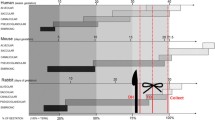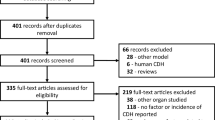Abstract
Purpose
The pathogenesis of pulmonary hypoplasia associated with congenital diaphragmatic hernia (CDH) remains unclear. Interactions between the epithelium and surrounding mesenchyme play an important role in normal lung morphogenesis. Epimorphin, a stromal protein, plays a role in epithelial morphogenesis and lung branching, both of which are involved in pulmonary hypoplasia. In this study, we aimed to examine the relationship between epimorphin and pulmonary hypoplasia associated with CDH in an animal model.
Methods
Time-pregnant rats were exposed to nitrofen or vehicle on gestational day 9 (D9). Fetuses were harvested on D16 and D20, and were divided into control, hypoplastic lungs with CDH (CDH+), and hypoplastic lungs without CDH (CDH−). Both lungs of each fetus were removed and subjected to morphometric and molecular biologic analyses. Lung-to-body weight ratios were calculated. Pulmonary RNA was extracted, and relative mRNA level of epimorphin was determined by quantitative real-time PCR (qRT-PCR). Protein expression of epimorphin was investigated by Western blotting.
Results
In groups D16 and D20, lung-to-body weight ratios in subgroups CDH+ were significantly lower than those of controls and CDH−. The relative mRNA expression levels of epimorphin were significantly increased in both lungs in subgroup CDH+ compared with controls and CDH− on D16. Pulmonary epimorphin gene expression levels were significantly decreased in CDH+ group on D20 compared to controls. Western blotting confirmed the qRT-PCR results showing decreased pulmonary epimorphin protein expression in CDH+ hypoplastic lungs compared to controls on D20.
Conclusion
Our study shows that there is an association between the epimorphin expression and pulmonary hypoplasia associated with CDH. Although the cause–effect relationship is far from being established, epimorphin-related mechanisms have a more critical role in early (D16) developmental stage.



Similar content being viewed by others
References
Tovar JA (2012) Congenital diaphragmatic hernia. Orphanet J Rare Dis 7:1. doi:10.1186/1750-1172-7-1
Stevens TP, Van Wijngaarden E, Ackerman KG, Lally PA, Lally KP (2009) Timing of delivery and survival rates for infants with prenatal diagnosis of congenital diaphragmatic hernia. Pediatrics 123:494–502. doi:10.1542/peds.2008-0528
Rowe MI, O’Neil JA, Grosfeld JL (1995) Prenatal diagnosis and fetal surgery. In: Rowe MI (ed) Essentials of pediatric surgery, 1st edn. Mosby, St. Louis, pp 15–24
Jesudason EC, Connell MG, Ferning DG, Lloyd DA, Losty PD (2000) In vitro effects of growth factors on lung hypoplasia in a model of congenital diaphragmatic hernia. J Pediatr Surg 35:914–922. doi:10.1053/jpsu.2000.6919
Stolar CJH, Dillon PW (1998) Congenital diaphragmatic hernia and eventration. In: O’Neil JA, Rowe MI, Grosfeld JL (eds) Pediatric surgery, 5th edn. Mosby, St. Louis, pp 819–837
Jesudason C, Connell M, Ferning DG, Lloyd DA, Losty PD (2000) Early lung malformations in congenital diaphragmatic hernia. J Pediatr Surg 35:124–128. doi:10.1016/S0022-3468(00)80028-7
Warburton D, Schwarz M, Tefft D, Flores-Delgado G, Anderson KD, Cardoso WV (2000) The molecular basis of lung morphogenesis. Mech Dev 92:55–81. doi:10.1016/S0925-4773(99)00325-1
Tsao KJ, Lally KP (2012) Congenital diaphragmatic hernia and eventration. In: Holcomb GW III, Murphy PJ, Ostlie DJ (eds) Ashcraft’s pediatric surgery, 6th edn. Elsevier Saunders, London, pp 315–340
Koshida S, Hirai Y (1997) Identification of cellular recognition sequence of epimorphin and critical role of cell/epimorphin interaction in lung branching morphogenesis. Biochem Biophys Res Commun 234:522–525. doi:10.1006/bbrc.1997.6673
Hirai Y, Takebe K, Takashina M, Kobayashi S, Takeichi M (1992) Epimorphin: a mesenchymal protein essential for epithelial morphogenesis. Cell 69:471–481. doi:10.1016/0092-8674(92)90448-L
Hirai Y, Lochter A, Galosy S, Koshida S, Nıwa S, Bissel MJ (1998) Epimorphin functions as a key morphoregulator for mammary epithelial cells. J Cell Biol 140:159–169. doi:10.1083/jcb.140.1.159
Lehnert L, Lerch MM, Hirai Y (2001) Autocrine stimulation of human pancreatic duct-like development by soluble isoforms of epimorphin in vitro. J Cell Biol 152:911–922. doi:10.1083/jcb.152.5.911
Miura K, Nagai H, Ueno Y (2003) Epimorphin is involved in differentiation of rat hepatic stem-like cells through cell–cell contact. Biochem Biophys Res Commun 311:415–423. doi:10.1016/j.bbrc.2003.09.225
Fritsch C, Swietlicki EA, Lefebvre O (2002) Epimorphin expression in intestinal myofibroblasts induces epithelial morphogenesis. J Clin Invest 110:1629–1641. doi:10.1172/JCI13588
Shaker A, Swietlicki EA, Wang L, Jiang S, Onal B, Bala S, DeSchryver K, Newberry R, Levin MS, Rubin DC (2010) Epimorphin deletion protects mice from inflammation-induced colon carcinogenesis and alters stem cell niche myofibroblast secretion. J Clin Invest 120:2081–2093. doi:10.1172/JCI40676
Chen CS, Nelson CM, Khauv D, Bennett S, Radisky ES, Hirai Y, Bissell MJ, Radisky DC (2009) Homology with vesicle fusion mediator syntaxin-1a predicts determinants of epimorphin/syntaxin-2 function in mammary epithelial morphogenesis. J Biol Chem 284:6877–6884. doi:10.1074/jbc.M805908200
Yamada M, Oda T, Higashi K, Kushiyama T, Yamakami K, Sakurai Y, Hirai Y, Yamamoto K, Hyodo T, Suzuki S, Miura S, Kumagai H (2010) Involvement of epimorphin in the repair of experimental renal fibrosis in mice. Lab Invest 90:867–880. doi:10.1038/labinvest.2010.50
Greer JJ (2013) Current concepts on the pathogenesis and etiology of congenital diaphragmatic hernia. Respir Physiol Neurobiol 189:232–240. doi:10.1016/jresp2013040159
Zha H, Remmers EF, Szpirer C, Szpirer J, Zhang H, Kozak CA, Wilder RL (1996) The epimorphin gene is highly conserved among humans, mice, and rats and maps to human chromosome 7, mouse chromosome 5, and rat chromosome 12. Genomics 37:386–389. doi:10.1006/geno.1996.0574
American Thoracic Society/European Respiratory Society International Multidisciplinary Consensus (2002) Classification of the idiopathic interstitial pneumonias. Am J Respir Crit Care Med 165:277–304. doi:10.1164/ajrccm.165.2.ats01
Iritani I (1984) Experimental study on embryogenesis of congenital diaphragmatic hernia. Anat Embryol 169:133–139. doi:10.1007/BF00303142
Li J, Hu T, Liu W, Xiang B, Jiang X (2004) Effect of epidermal growth factor on pulmonary hypoplasia in experimental diaphragmatic hernia. J Pediatr Surg 39:37–42. doi:10.1016/j.jpedsurg.2003.09.014
Langwieler T, Fiegel HC, Alaamian M, Mann O, Beshir I, Izbicki JR, Kluth D (2004) The relationship of diaphragmatic defect, liver growth, and lung hypoplasia in nitrofen-induced congenital diaphragmatic hernia in the rat. Pediatr Surg Int 7:509–514. doi:10.1007/s00383-004-1226-3
Taira Y, Oue T, Shima H, Miyazaki E, Puri P (1999) Increased tropoelastin and procollagen expression in the lung of nitrofen-induced diaphragmatic hernia in rats. J Pediatr Surg 34:715–719. doi:10.1016/S0022-3468(99)90362-7
Losada A, Xia H, Migliazza L, Diez-Pardo JA, Santisteban P, Tovar JA (1999) Lung Hypoplasia caused by nitrofen is mediated by down-regulation of thyroid transcription factor TTF-1. Pediatr Surg Int 15:188–191. doi:10.1007/s003830050551
Unemoto K, Sakai M, Shima H, Guarino N, Puri P (2003) Increased expression of ICAM-1 and VCAM-1 in the lung of nitrofen-induced congenital diaphragmatic hernia in rats. Pediatr Surg Int 19:365–370. doi:10.1016/j.jpedsurg.2003.09.014
Mychaliska B, Officer M, Heintz K, Starcher BC, Pierce RA (2004) Pulmonary elastin expression is decreased in the nitrofen-induced rat model of congenital diaphragmatic hernia. J Pediatr Surg 39:666–671. doi:10.1016/j.jpedsurg.2004.01.028
Kamiyama M, Usui N, Kamata S, Fukuzawa M, Nagaya N, Kangawa KJ (2005) Adrenomedullin is up-regulated in nitrofen-induced fetal pulmonary hypoplasia. J Pediatr Surg 40:1562–1567. doi:10.1016/j.jpedsurg.2005.06.005
Akiyama M, Amagai M, Smith LT, Hashımoto K, Shımızu H, Nıshıkawa T (1999) Epimorphin expression during human foetal hair follicle development. Br J Dermatol 141:447–452. doi:10.1046/j.1365-2133.1999.03037.x
Terasaki Y, Fukuda Y, Suga M, Ikeguchi N, Takeya M (2005) Epimorphin expression in interstitial pneumonia. Respir Res 6:6. doi:10.1186/1465-9921-6-6
Tulachan SS, Doi R, Hirai Y, Kawaguchi Y, Koizumi M, Hembree M, Tei E, Crowley A, Yew H, McFall C, Prasadan K, Preuett B, Imamura M, Gittes GK (2006) Mesenchymal epimorphin is important for pancreatic duct morphogenesis. Dev Growth Differ 48:65–72. doi:10.1111/j.1440-169X.2006.00846.x
Yoshino R, Miura K, Segawa D, Hirai Y, Goto T, Ohshima S, Mikami K, Yoneyama K, Shibuya T, Watanabe D, Kataoka E, Takeuchi S, Endoh A, Sato W, Watanabe S (2006) Epimorphin expression and stellate cell status in mouse liver injury. Hepatol Res 34:238–249. doi:10.1016/j.hepres.2005.12.011
Zhang L, Ishikawa O, Takeuchi Y, Miyachi Y (1998) Immunohistochemical distribution of epimorphin in human and mouse tissues. Histochem J 30:903–908. doi:10.1023/A:1003485503117
Acknowledgments
The authors wish to thank Philip Jacobs for his suggestions on preparing the manuscript. This paper comprises the results of a project supported by The Scientific Research Projects Coordination Unit of Akdeniz University (Project No: 04.0103.005).
Conflict of interest
The authors report no conflict of interest.
Author information
Authors and Affiliations
Corresponding author
Rights and permissions
About this article
Cite this article
Akpinar, İ., Korgun, D., Çetin, A. et al. Epimorphin expression in a rat model of pulmonary hypoplasia associated with congenital diaphragmatic hernia. Pediatr Surg Int 30, 1037–1043 (2014). https://doi.org/10.1007/s00383-014-3579-6
Accepted:
Published:
Issue Date:
DOI: https://doi.org/10.1007/s00383-014-3579-6




